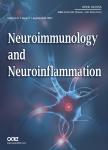Favorable and unfavorable roles of microglia and macrophages in the pathologic central nervous system
作者机构:Department of Molecular and Cellular Physiology Graduate School of Medicine Ehime University Toon Ehime 791-0295 Japan
出 版 物:《Neuroimmunology and Neuroinflammation》 (神经免疫与神经炎症(英文版))
年 卷 期:2020年第7卷第2期
页 面:73-91页
主 题:Parkinson's disease stroke traumatic brain injury axotomy spinal cord glucocorticoid noradrenaline bromovalerylurea
摘 要:Resident microglia in the central nervous system (CNS) are activated rapidly in response to even minor pathologic changes in the CNS, releasing various cytokines, growth factors, reactive oxygen species and other bioactive substances, in addition to eliminating synapses and degenerating cells through phagocytosis. Monocytes in circulation invade the inflamed brain tissues and develop into macrophages that also produce several bioactive substances and engage in phagocytosis. This article introduces methods for distinguishing microglia and macrophages. The pathophysiological roles of resident microglia and macrophages are discussed in animal models with neuroinflammation in the brain either with or without disruption of the blood-brain barrier. Both cell types have ameliorating and aggravating effects on the pathologic CNS, and their different roles are addressed in this article. Furthermore, this article compares the effects of some pharmacological interventions to induce phenotypic cellular changes for improved outcomes of the pathologic CNS.



